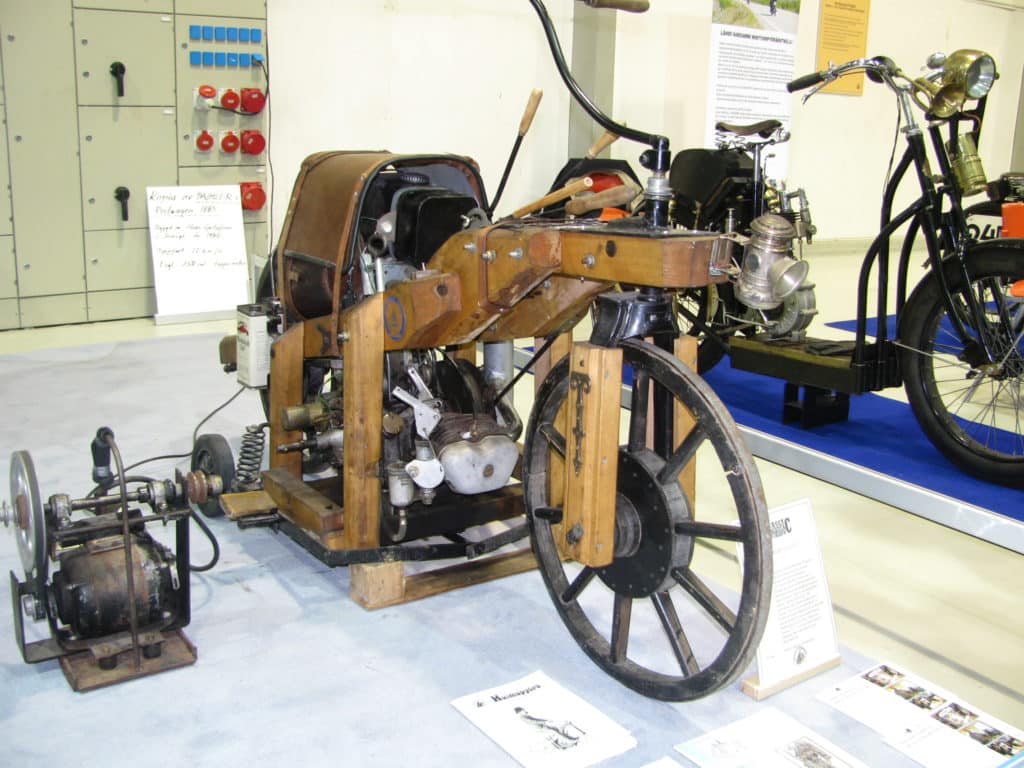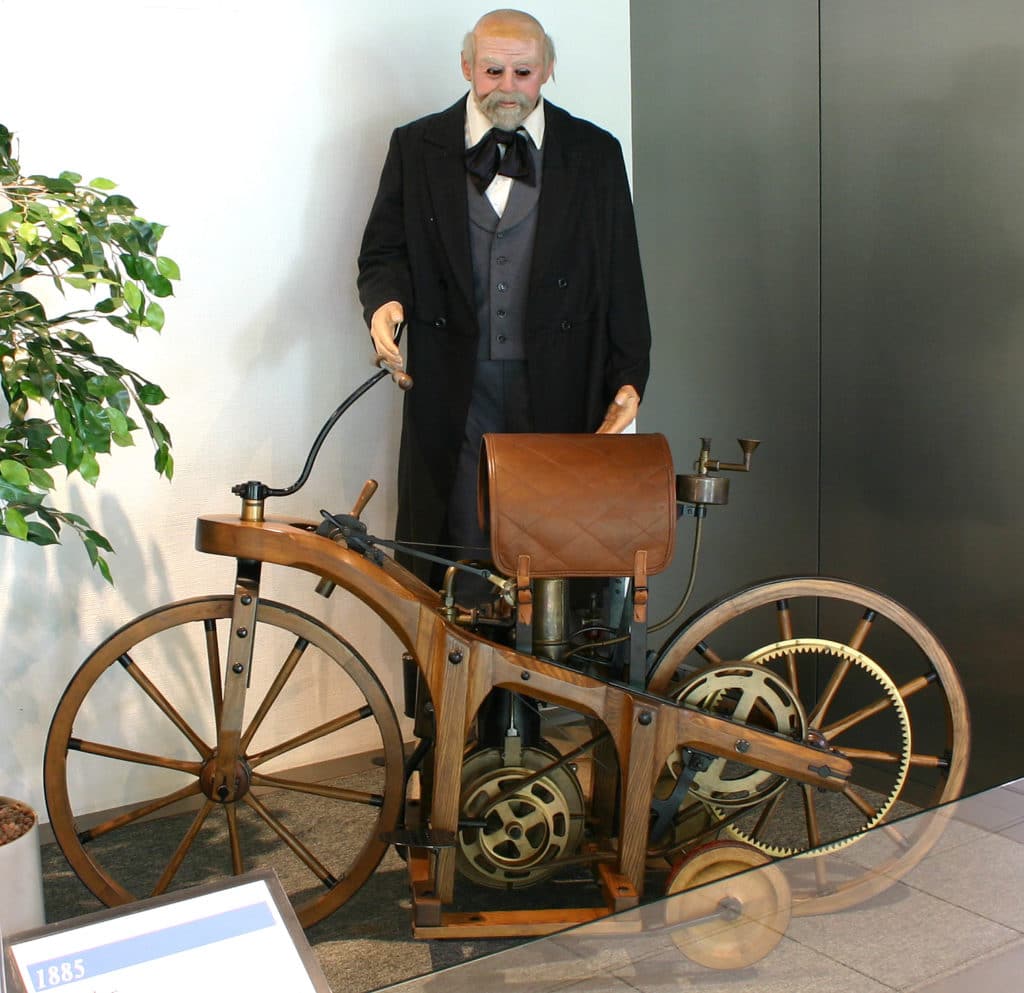Introduction
Overview of the invention of the motorbike and its significance
The invention of the motorcycle can be traced back to the late 19th century when there was a need for a faster and more efficient means of transportation. The early motorbikes were born out of necessity, as people sought to find a solution to travel faster and cover longer distances.
One of the pioneers in the development of the motorcycle was Gottlieb Daimler, who built the first gas-powered two-wheeler in 1885. His invention was a revolutionary step in the evolution of transportation, as it provided an alternative to horse-drawn carriages and bicycles.
The significance of the motorcycle invention lies in its ability to bridge the gap between personal travel and mass transportation. Unlike cars or trains, motorcycles offered individuals a sense of freedom and maneuverability, allowing them to navigate through congested city streets and explore rural areas with ease.
The evolution of motorcycles and their impact on transportation
Over the years, motorcycles have continued to evolve and adapt to the changing needs and preferences of riders. With the advancements in technology, motorcycles have become faster, more powerful, and more fuel-efficient.
In the early 20th century, several motorcycle brands emerged, each contributing to the development of the industry. Companies like Harley-Davidson, Triumph, and Indian established their place in history by producing iconic motorcycles that became symbols of power and rebellion.
As time progressed, motorcycles became not just a means of transportation but also a form of expression and a way of life. Different models and styles were introduced, catering to various riding preferences such as cruisers, sport bikes, and adventure bikes.
The impact of motorcycles on transportation cannot be underestimated. They have provided people with an affordable and efficient mode of transportation, especially in areas where public transport is limited. Motorcycles have also played a significant role in delivering goods and services, particularly in congested urban areas.
In conclusion, the invention and evolution of motorcycles have had a profound impact on transportation. From humble beginnings as a necessity, motorcycles have become a global phenomenon, captivating the hearts and minds of riders around the world. With continued advancements in technology, we can expect motorcycles to continue evolving and shaping the future of transportation.
The Early Years: 1885-1915
The invention of the motorbike and its early prototypes
The invention of the motorcycle in the late 19th century marked a significant milestone in transportation history. Born out of the need for faster and more efficient means of travel, the early motorbikes were a result of constant experimentation and innovation. These early prototypes were more akin to today’s mopeds, with bicycles powered by small engines.
It all began with the velocipede, a popular early bicycle in the 19th century that had its pedals attached to its front wheel axle. However, it was not until 1867 when American inventor Sylvester Roper created a machine that more closely resembled what we now recognize as a motorcycle. Roper’s invention featured a steam-powered engine attached to a bicycle frame, making it one of the earliest machines of its kind.
Key inventors and their contributions to early motorcycle development
While Sylvester Roper’s invention was an important milestone, it was Gottlieb Daimler who revolutionized motorcycle design with his gas-powered two-wheeler in 1885. Daimler’s invention provided an alternative to horse-drawn carriages and bicycles and paved the way for the future of motorcycle transportation.
The creations of early motorcycle pioneers such as Daimler laid the foundation for future developments in the industry. Companies like Harley-Davidson, Triumph, and Indian emerged in the early 20th century, each making significant contributions to the evolution of motorcycles. These brands produced iconic motorcycles that became symbols of power and rebellion.
As the years went by, motorcycles continued to evolve and adapt to the changing needs of riders. Technological advancements led to faster, more powerful, and more fuel-efficient bikes. Different models and styles were introduced, catering to various riding preferences.
The impact of motorcycles on transportation cannot be underestimated. They have provided an affordable and efficient mode of travel, particularly in areas with limited public transport options. Furthermore, motorcycles have played a significant role in delivering goods and services, especially in congested urban areas.
In conclusion, the invention and evolution of motorcycles have had a profound impact on transportation. From their humble beginnings as a necessity, motorcycles have become a global phenomenon, capturing the hearts and minds of riders worldwide. With continued advancements in technology, the future of motorcycles looks promising, as they continue to shape the future of transportation.

The Traub: A Mysterious Creation
The story behind the Traub, a unique and advanced motorcycle from 1916
The 1916 Traub motorcycle is a one-of-a-kind classic American motorcycle that has captivated enthusiasts for decades. The story of this motorcycle is like something out of a mystery novel. Discovered in 1967, the Traub was found entombed behind a wall in a Chicago area home, adding an air of intrigue to its already unique history. Built entirely by hand, the Traub was far ahead of its time.
Uncovering the history of the Traub and its technological innovations
The 1916 Traub motorcycle was built during a time when the motorcycle industry was rapidly evolving. With its advanced design and features, the Traub showcased the ingenuity and creativity of its creator. While it was not as well known as other popular motorcycle brands of the time, such as Harley-Davidson or Kawasaki, the Traub’s innovations were ahead of its time.
The Traub motorcycle featured groundbreaking technology, including a unique engine design and exceptional performance capabilities. It was a testament to the engineering prowess of its creator and represented a significant advancement in motorcycle technology.
Despite its mysterious history, the story of the Traub motorcycle is a testament to the passion and dedication of motorcycle enthusiasts. Its discovery and subsequent restoration have allowed riders and collectors to appreciate its unique design and innovative features.
The 1916 Traub motorcycle remains a rare and prized possession among motorcycle collectors. Its place in history as a remarkable and advanced machine continues to capture the imagination of those who are passionate about motorcycles.
The Rise of the Motorcycle Industry: 1920s-1930s
The booming popularity of motorcycles during the 1920s-1930s
The 1920s and 1930s saw a significant surge in the popularity of motorcycles. This period marked a turning point in the industry, with a large influx of sales and a growing number of motorcycle enthusiasts.
During this time, motorcycles became more than just a mode of transportation. They represented freedom, adventure, and a sense of rebellion. The thrill of riding on two wheels attracted people from all walks of life, and the motorcycle culture started to gain momentum.
With the increase in demand, motorcycle manufacturers saw an opportunity to cater to a wider audience. Many well-known companies, such as Moto Guzzi and BMW, emerged during this time and established themselves as leaders in the industry. These companies recognized the changing preferences of riders and introduced innovative designs and technologies to meet their needs.
Introduction of well-known companies and the establishment of the American Motorcyclist Association
One notable development during the 1920s-1930s was the establishment of the American Motorcyclist Association (AMA). Founded in 1924, the AMA served as a platform for motorcycle enthusiasts to come together, share their passion, and advocate for their rights.
The AMA played a crucial role in promoting motorcycle safety, organizing races and events, and lobbying for legislation that benefited riders. It provided a unified voice for the motorcycle community and helped shape the industry’s growth and development.
In addition to the AMA, various motorcycle clubs and organizations also emerged during this period. These groups fostered camaraderie among riders, organized social rides and events, and contributed to the overall growth of the motorcycle culture.
Overall, the 1920s-1930s marked a transformative era for the motorcycle industry. The increasing popularity of motorcycles, the emergence of well-known companies, and the establishment of the AMA and other organizations laid the foundation for the vibrant and thriving industry that we see today.

The Rise of the Motorcycle Industry: 1920s-1930s
The booming popularity of motorcycles during the 1920s-1930s
The 1920s and 1930s witnessed a significant surge in the popularity of motorcycles. This period marked a turning point in the industry, with a large influx of sales and a growing number of motorcycle enthusiasts.
During this time, motorcycles transformed from simply being a mode of transportation to representing freedom, adventure, and a sense of rebellion. The thrill of riding on two wheels attracted people from all walks of life, and as a result, the motorcycle culture began to gain momentum.
Motorcycle manufacturers seized the opportunity to cater to a wider audience with the increasing demand. Esteemed companies such as Moto Guzzi and BMW emerged during this time and established themselves as industry leaders. These companies recognized the changing preferences of riders and introduced innovative designs and technologies to meet their needs.
Introduction of well-known companies and the establishment of the American Motorcyclist Association
A notable development during the 1920s-1930s was the creation of the American Motorcyclist Association (AMA). Established in 1924, the AMA provided a platform for motorcycle enthusiasts to come together, share their passion, and advocate for their rights.
The AMA played a crucial role in promoting motorcycle safety, organizing races and events, and lobbying for legislation that benefited riders. It provided a unified voice for the motorcycle community and contributed to the industry’s growth and development.
Furthermore, various motorcycle clubs and organizations emerged during this period, fostering camaraderie among riders. These groups organized social rides and events, contributing to the overall growth of the motorcycle culture.
Overall, the 1920s-1930s marked a transformative era for the motorcycle industry. The increasing popularity of motorcycles, the emergence of well-known companies, and the establishment of the AMA and other organizations laid the foundation for the vibrant and thriving industry that we see today.
World War II and Post-war Era: 1940s-1950s
The impact of World War II on motorcycle production and usage
World War II had a significant impact on the motorcycle industry. During the war, motorcycles played a crucial role in military operations. They were used by the military for a variety of purposes, including messenger services, reconnaissance missions, and transportation of troops and supplies.
This wartime usage of motorcycles increased their visibility and utility, boosting their popularity and instilling a sense of ruggedness and reliability.
However, the war also had a negative impact on civilian motorcycle production as resources were diverted towards military needs. Many motorcycle manufacturers shifted their focus to producing motorcycles for the armed forces, leading to a decline in civilian production and availability.
Following the war, there was a surge in demand for motorcycles as soldiers returning from the war sought the thrill and freedom they experienced while riding in the military. This demand, coupled with the post-war economic boom, led to a resurgence in civilian motorcycle production and a newfound enthusiasm for motorcycles.
The growth of motorcycle culture and the emergence of biker clubs
The post-war era saw the rapid growth of motorcycle culture and the emergence of biker clubs. Motorcycles became synonymous with rebellion and counterculture, attracting a dedicated following of individuals seeking adventure and camaraderie.
Biker clubs, such as the Hells Angels and the Outlaws, gained notoriety during this time. These clubs provided a sense of belonging and brotherhood for motorcyclists, organizing rides, events, and fostering a strong community spirit.
The motorcycle culture became an integral part of popular culture, with movies like “The Wild One” and “Easy Rider” further cementing motorcycles’ association with rebellion and freedom.
Motorcycles also became more accessible to the general public in the post-war era. The increasing affordability, improved infrastructure, and expanding road networks allowed more people to experience the joy and exhilaration of riding a motorcycle.
The legacy of World War II, combined with the post-war economic boom and the growth of motorcycle culture, laid the foundation for the enduring popularity and importance of motorcycles in our society today.
Motorcycle Innovations: 1960s-1970s
Advancements in motorcycle technology during the 1960s-1970s
The 1960s and 1970s were a period of significant advancements in motorcycle technology. Manufacturers focused on improving performance, safety, and comfort, resulting in innovations that shaped the industry.
During this time, motorcycle engines became more powerful and efficient, allowing for higher speeds and better acceleration. Improved suspension systems provided riders with a smoother and more comfortable ride, particularly when navigating rough terrains.
Another notable advancement was the introduction of electric starters, making it easier for riders to start their motorcycles compared to using a kickstarter. This innovation improved convenience and eliminated the physical strain of kickstarting, especially for larger and heavier motorcycles.
In addition to performance enhancements, manufacturers also incorporated safety features into motorcycles. One significant development was the introduction of disc brakes. Disc brakes provided superior stopping power and improved braking performance, ensuring better control and reducing the risk of accidents.
Introduction of features like disc brakes and electric starters
The adoption of new features like disc brakes and electric starters became increasingly common in motorcycles during the 1960s-1970s. These features were initially introduced in higher-end models but gradually made their way into mainstream motorcycles.
Disc brakes revolutionized braking systems, offering better heat dissipation and resistance to fading compared to traditional drum brakes. The introduction of this feature significantly improved motorcycle safety and inspired further advancements in braking technology.
Similarly, electric starters eliminated the need for physical exertion when starting a motorcycle. This feature allowed riders to start their bikes easily with a push of a button, enhancing convenience and accessibility.
The innovations of the 1960s-1970s era transformed motorcycles into more efficient, powerful, and safer machines. These advancements not only improved the riding experience but also laid the groundwork for future developments in motorcycle technology.

The Evolution of Motorcycle Design: 1980s-1990s
Changes in motorcycle aesthetics and design trends
During the 1980s and 1990s, motorcycle design underwent significant changes. Aesthetics played a crucial role in attracting riders, and manufacturers started focusing on creating sleeker and more visually appealing motorcycles. The design trends of this era saw a shift towards aerodynamic shapes, angular lines, and aggressive styling. Motorcycles became more streamlined, resembling futuristic machines that exuded power and speed.
The introduction of lightweight materials and improved engine performance
In addition to changes in aesthetics, the 1980s and 1990s also brought advancements in materials and engine technology. Manufacturers began incorporating lightweight materials like aluminum and carbon fiber, resulting in lighter and more maneuverable motorcycles. This allowed riders to experience improved handling and better control over their bikes.
Engine performance also saw significant improvements during this era. Fuel injection systems replaced carburetors, resulting in more precise fuel delivery and better throttle response. This technology improved overall engine efficiency, providing riders with increased power and smoother acceleration.
Moreover, the development of liquid-cooled engines allowed motorcycles to better handle the demands of high-performance riding. Liquid cooling systems improved engine reliability and allowed for higher power outputs without the risk of overheating.
These advancements in both aesthetics and technology during the 1980s and 1990s transformed motorcycles into even more thrilling machines. The introduction of lightweight materials and improved engine performance not only enhanced the riding experience but also set the stage for further innovations in the years to come.
By constantly pushing the boundaries of design and technology, motorcycle manufacturers have shaped the industry and continuously catered to the desires of motorcycle enthusiasts around the world. The evolution of motorcycles throughout different eras showcases how advancements in technology, changes in design trends, and the demands of riders have driven the progress of this iconic mode of transportation. From early innovations to modern-day masterpieces, motorcycles continue to capture the imagination and ignite the passion of riders worldwide.

The Evolution of Motorcycle Design: 1980s-1990s
Changes in motorcycle aesthetics and design trends
During the 1980s and 1990s, motorcycle design underwent significant changes. Aesthetics played a crucial role in attracting riders, and manufacturers started focusing on creating sleeker and more visually appealing motorcycles. The design trends of this era saw a shift towards aerodynamic shapes, angular lines, and aggressive styling. Motorcycles became more streamlined, resembling futuristic machines that exuded power and speed.
The introduction of lightweight materials and improved engine performance
In addition to changes in aesthetics, the 1980s and 1990s also brought advancements in materials and engine technology. Manufacturers began incorporating lightweight materials like aluminum and carbon fiber, resulting in lighter and more maneuverable motorcycles. This allowed riders to experience improved handling and better control over their bikes.
Engine performance also saw significant improvements during this era. Fuel injection systems replaced carburetors, resulting in more precise fuel delivery and better throttle response. This technology improved overall engine efficiency, providing riders with increased power and smoother acceleration.
Moreover, the development of liquid-cooled engines allowed motorcycles to better handle the demands of high-performance riding. Liquid cooling systems improved engine reliability and allowed for higher power outputs without the risk of overheating.
These advancements in both aesthetics and technology during the 1980s and 1990s transformed motorcycles into even more thrilling machines. The introduction of lightweight materials and improved engine performance not only enhanced the riding experience but also set the stage for further innovations in the years to come.
By constantly pushing the boundaries of design and technology, motorcycle manufacturers have shaped the industry and continuously catered to the desires of motorcycle enthusiasts around the world. The evolution of motorcycles throughout different eras showcases how advancements in technology, changes in design trends, and the demands of riders have driven the progress of this iconic mode of transportation. From early innovations to modern-day masterpieces, motorcycles continue to capture the imagination and ignite the passion of riders worldwide.
Modern Motorcycles and Beyond: 2000s-Present
The advancements in motorcycle technology in the 21st century
The 21st century has seen remarkable advancements in motorcycle technology. Manufacturers have continuously introduced new features and cutting-edge innovations to enhance the riding experience. Here are some key advancements that have shaped modern motorcycles:
- Improved safety features: Manufacturers have integrated advanced safety features such as anti-lock braking systems (ABS), traction control, and electronic stability control. These technologies help riders maintain control of their motorcycles and prevent accidents.
- Enhanced connectivity: Many modern motorcycles come equipped with Bluetooth connectivity and smartphone integration. This allows riders to access navigation, music, and communication functions directly from their bikes, enhancing convenience and providing a more connected riding experience.
- Advanced suspension systems: Suspension technology has also seen significant advancements, with the introduction of electronically controlled suspension systems. These systems automatically adjust damping and spring rates to adapt to varying road conditions, providing a smoother and more comfortable ride.
- High-performance engines: The development of high-performance engines has continued in the 21st century, with manufacturers pushing the limits of power and efficiency. Advanced technologies such as variable valve timing, multiple fuel injection systems, and turbocharging have led to increased horsepower and improved fuel economy.
The rise of electric motorcycles and the future of motorcycling
With growing concerns about environmental impact and the need for sustainable transportation solutions, electric motorcycles have gained significant attention in recent years. Electric motorcycles offer several advantages, including zero-emission operation, quiet performance, and instant torque delivery.
Leading motorcycle manufacturers, as well as startups, have been investing in electric motorcycle technology, resulting in the development of impressive electric models. These motorcycles offer comparable performance to their combustion engine counterparts while reducing dependence on fossil fuels.
The future of motorcycling is likely to be heavily influenced by electric motorcycles. As technology advances and battery range improves, we can expect to see further adoption of electric motorcycles and the integration of advanced features such as fast charging infrastructure and increased battery efficiency.
In conclusion, the evolution of motorcycles has been a journey of continuous innovation and adaptation. From the sleek designs and improved performance of the 1980s and 1990s to the advanced technologies and electric mobility of the 21st century, motorcycles have continually evolved to meet the changing needs and desires of riders. Whether it’s the thrill of speed, the freedom of the open road, or the desire for sustainable transportation, motorcycles continue to capture the hearts of enthusiasts and shape the future of transportation.
Conclusion
Reflecting on the origins and evolution of motorcycles
The evolution of the motorcycle has been a captivating journey that traces its roots back to the invention of the Laufmaschine in 1817. Over the past century, motorcycles have undergone remarkable advancements in design and technology, shaping them into the thrilling machines we know today. From the sleek and aggressive aesthetics of the 1980s and 1990s to the cutting-edge innovations of the 21st century, motorcycles have continuously adapted to meet the changing needs and desires of riders.
During the 1980s and 1990s, motorcycle design underwent significant changes with a focus on aerodynamic shapes and angular lines. Manufacturers incorporated lightweight materials like aluminum and carbon fiber, resulting in lighter and more maneuverable bikes. Engine performance saw improvements as well, with the introduction of fuel injection systems and liquid-cooled engines, providing riders with increased power and smoother acceleration.
In the 21st century, motorcycles have continued to evolve with the integration of advanced safety features, enhanced connectivity, advanced suspension systems, and high-performance engines. Additionally, electric motorcycles have emerged as a sustainable alternative, offering zero-emission operation and instant torque delivery. As technology advances and electric mobility becomes more widespread, the future of motorcycling is likely to be heavily influenced by electric motorcycles and the integration of advanced features such as fast charging infrastructure.
The enduring legacy and cultural impact of the motorbike
Motorcycles have left a lasting impact on popular culture and the way we view transportation. The freedom and exhilaration that come with riding a motorcycle have captured the hearts of enthusiasts around the world. From movies and music to fashion and lifestyle, the motorcycle lifestyle has cemented its place as an iconic symbol of rebellion, adventure, and individuality.
Moreover, motorcycles have played a role in shaping social movements and subcultures, such as the biker culture and motorcycle clubs. These communities have created a sense of belonging and camaraderie among riders, fostering a unique bond that transcends boundaries.
In conclusion, the evolution of motorcycles has been a testament to human ingenuity and the spirit of innovation. From its humble beginnings as a balance bike to the cutting-edge machines of today, motorcycles continue to inspire and captivate riders worldwide. As we look back on their origins and forward to the future, we can appreciate the enduring legacy and cultural significance of the motorbike.
Who Invented the Motorbike: Exploring the Origins and Evolution of Motorcycles
Q: Who invented the motorbike?
A: The exact inventor of the motorbike is still a topic of debate, as there were several pioneers who made significant contributions. However, it is widely accepted that the first practical motorcycle was created by Gottlieb Daimler and Wilhelm Maybach in 1885.
Q: What did the early motorbikes look like?
A: Early motorbikes resembled bicycles with a small internal combustion engine attached to the frame. They had two large wheels, pedals for assistance, a simple fuel tank, and a rudimentary handlebar for steering.
Q: How did motorcycles evolve over time?
A: From their humble beginnings, motorcycles evolved significantly. They transitioned from being an alternative to bicycles to becoming powerful machines capable of high speeds. Over the years, advancements were made in engine technology, frame design, comfort features, and overall performance.
Q: Who were some notable contributors to the development of motorcycles?
A: In addition to Daimler and Maybach, other notable contributors to the evolution of motorcycles include Karl Benz, Hildebrand & Wolfmüller, Sylvester Roper, and many more. These inventors made important discoveries and innovations that shaped the future of motorcycles.
Q: When did motorcycles become popular?
A: Motorcycles gained popularity in the late 19th and early 20th centuries. They offered a convenient and affordable mode of transportation, especially for short distances, and quickly appealed to a wide range of riders. Motorcycles continued to evolve and adapt to societal needs, solidifying their place in popular culture.
Q: How did motorcycles impact society?
A: Motorcycles had a profound impact on society. They revolutionized personal transportation, offering independence and mobility to individuals. They played a crucial role in transporting people and goods during war times, influenced the entertainment industry through motorcycle gangs and iconic films, and even became a symbol of rebellion and freedom.
Q: What are some iconic motorcycle brands?
A: There are numerous iconic motorcycle brands that have left a lasting impression, such as Harley-Davidson, Triumph, Honda, Ducati, BMW, Kawasaki, and Yamaha. Each brand has its own unique style and heritage, contributing to the diverse world of motorcycles.
Q: Any famous motorcycle enthusiasts?
A: Many famous individuals are enthusiastic about motorcycles. Celebrities such as Steve McQueen, Ewan McGregor, Brad Pitt, Keanu Reeves, and Tom Cruise are known for their love of motorcycles. Their passion for riding has further popularized this thrilling mode of transportation.
Q: Are motorcycles still being developed and improved today?
A: Absolutely! The motorcycle industry continues to innovate, with advancements in technology, design, and safety. Manufacturers are constantly introducing new models that are more efficient, reliable, and equipped with cutting-edge features to enhance the riding experience.
Q: What does the future hold for motorcycles?
A: The future of motorcycles is promising. The industry is transitioning towards electric motorcycles, embracing sustainable technologies to reduce emissions and promote environmental consciousness. Additionally, advancements in autonomous vehicle technology could potentially impact motorcycle design and safety features in the coming years.

David Williams is an author with a passion for motorcycles and all things related to the world of two-wheeled vehicles. His expertise is evident on his website, The Moto Expert, where he shares his knowledge and insights with fellow enthusiasts. Follow him on social media to stay up-to-date on the latest motorcycle news, reviews, and trends. Whether you’re a seasoned rider or just starting out, David’s content is sure to inform and entertain. Join his community and become a part of the conversation today.

